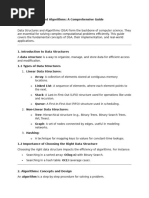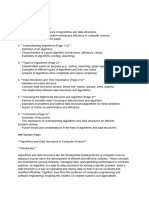Python
Uploaded by
mahinda bandaraPython
Uploaded by
mahinda bandaraSteps to learn Data Structures and Algorithms (DSA) with Python
1. Learn Python: If you're not already familiar with Python, start by learning the
basics of the language. There are many online resources and tutorials available for
free.
2. Understand the Basics: Before diving into DSA, make sure you have a good grasp
of Python's syntax, data types, and basic programming concepts.
3. Pick Good Learning Resources: Choose a good book, online course, or tutorial
series on DSA with Python. Most of the free stuff is already posted on the channel
4. Data Structures: Begin with fundamental data structures like lists, arrays,
stacks, queues, linked lists, trees, graphs, and hash tables. Understand their
properties, operations, and when to use them.
5. Algorithms: Study common algorithms such as searching (binary search, linear
search), sorting (quick sort, merge sort), and dynamic programming. Learn about
their time and space complexity.
6. Practice: The key to mastering DSA is practice. Solve a wide variety of problems
to apply your knowledge. Websites like LeetCode and HackerRank provide a vast
collection of problems.
7. Analyze Complexity: Learn how to analyze the time and space complexity of
algorithms. Big O notation is a crucial concept in DSA.
8. Implement Algorithms: Implement algorithms and data structures from scratch in
Python. This hands-on experience will deepen your understanding.
9. Project Work: Apply DSA to real projects. This could be building a simple game,
a small web app, or any software that requires efficient data handling.
10. Seek Help and Collaborate: Don't hesitate to ask for help when you're stuck.
Engage in coding communities, forums, or collaborate with others to gain new
insights.
11. Review and Revise: Periodically review what you've learned. Reinforce your
understanding by revisiting data structures and algorithms you've studied.
12. Competitive Programming: Participate in competitive programming contests. They
are a great way to test your skills and improve your problem-solving abilities.
13. Stay Updated: DSA is an ever-evolving field. Stay updated with the latest
trends and algorithms.
14. Contribute to Open Source: Consider contributing to open source projects. It's
a great way to apply your knowledge and work on real-world code.
15. Teach Others: Teaching what you've learned to others can deepen your
understanding. You can create tutorials or mentor someone.
You might also like
- How To Not Suck at Data Structures & Algorithms: Andrew CodesmithNo ratings yetHow To Not Suck at Data Structures & Algorithms: Andrew Codesmith10 pages
- Flow To Learn Data Structures and AlgorithmsNo ratings yetFlow To Learn Data Structures and Algorithms2 pages
- 0.0 Step-by-Step Guide to Master DSA using C++No ratings yet0.0 Step-by-Step Guide to Master DSA using C++1 page
- How I Mastered Data Structures and Algorithms - Ashish Pratap SinghNo ratings yetHow I Mastered Data Structures and Algorithms - Ashish Pratap Singh11 pages
- Comprehensive Guide to Data Structures and AlgorithmsNo ratings yetComprehensive Guide to Data Structures and Algorithms4 pages
- 1726498556206-bc10dee8-86f7-4ba9-a63a-ad606cb5b9e3__community_fileNo ratings yet1726498556206-bc10dee8-86f7-4ba9-a63a-ad606cb5b9e3__community_file3 pages
- Learn Data Structures and Algorithms _ DSA tutorials _ CodeChefNo ratings yetLearn Data Structures and Algorithms _ DSA tutorials _ CodeChef15 pages
- DSA Roadmap_ Learn Data Structure and Algorithms in 30 Days - DeV CommunityNo ratings yetDSA Roadmap_ Learn Data Structure and Algorithms in 30 Days - DeV Community3 pages
- Data Structures and Algorithms Suggestions byNo ratings yetData Structures and Algorithms Suggestions by3 pages
- 0 To 1 Path To Become A Master Coder: Tathastu RoadmapsNo ratings yet0 To 1 Path To Become A Master Coder: Tathastu Roadmaps14 pages
- How Can I Learn Algorithms and Data Structures From ScratchNo ratings yetHow Can I Learn Algorithms and Data Structures From Scratch2 pages
- Ashford D. Python for Algorithms and Data Structures 2024No ratings yetAshford D. Python for Algorithms and Data Structures 2024475 pages
- Explain Everything About Data Structures and Algo...No ratings yetExplain Everything About Data Structures and Algo...7 pages
- PROJECT REPORT ApnaRooms Manoranjan 12219036No ratings yetPROJECT REPORT ApnaRooms Manoranjan 1221903624 pages
- Hands-On Machine Learning Recommender Systems with Apache SparkFrom EverandHands-On Machine Learning Recommender Systems with Apache SparkNo ratings yet



























































